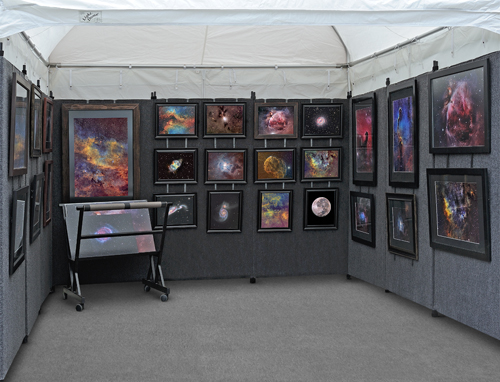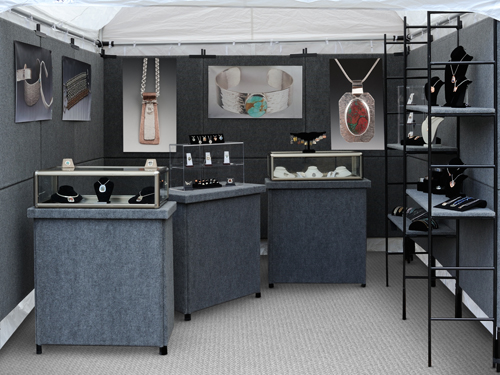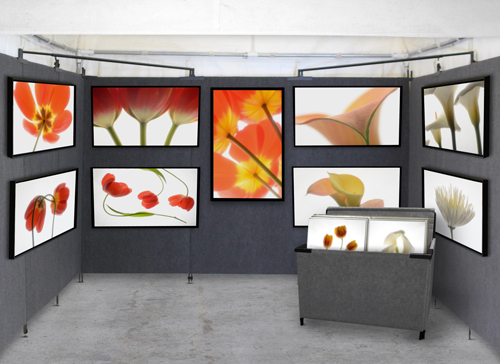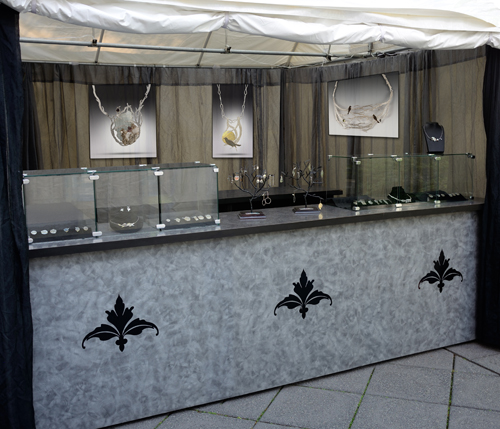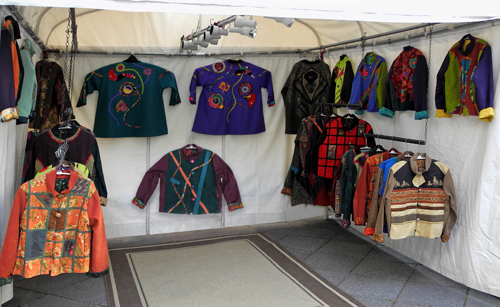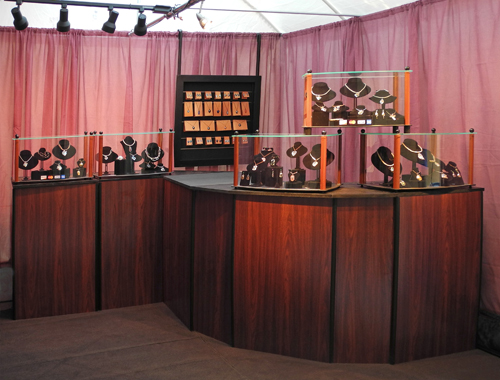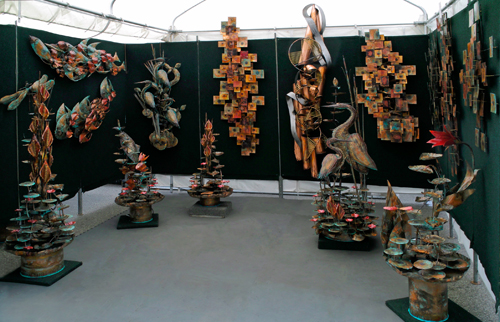|
| |
 |
|
|
|
Support
BermanGraphics |
|
|
| |
|
Hire me
to Prepare your Digital Jury Images |
|

|
|
How to Photograph Your Booth
from the September 2014 issue of Sunshine Artist Magazine
exactly as it was edited and ran in the magazine
scroll down (or click here) to see example booth photos
|
| download and print out the booth picture article |
The Art of the Booth Photo
Veteran tips on capturing your mobile gallery's inner beauty
by Larry Berman |
How important is the booth photo? Besides the artwork images required by juried events, the booth shot can easily make or break a working artist or craftsperson's festival career and even keep you out of shows where getting in is considered easy. Some artisans spend a great deal of money having their artwork photographed but don't think of improving their booth picture until they start an application - if they think about it at all. But like work images, the booth image needs to be read easily without causing jurors to spend even an extra second understanding exactly what they're seeing. They should glance at it, consider it to look professional and then spend their time evaluating your artwork. Moreover, keep in mind that jurors are seeing all of your images simultaneously for not more than 20 seconds and sometimes closer to 10. If you still don't think the booth image is that important, attend an open jury and view your competitor's images, or attend a mock (image-evaluation) jury and listen to the jurors' critiques. Simply put, the significance of a quality booth image cannot be overstressed - especially if you're hoping to get into 200 Best-ranked and other high-quality shows. Fortunately, getting a quality shot is within your reach with the foll wing useful tips. |
Setting the stage
The best place to photograph your booth is not at an art show where you don't have control over the environment or the weather. Instead, it's better to set up for the picture at home on an overcast or cloudy day, which ensures even lighting and avoids sun streaks that might draw jurors' eyes. Also, make sure there are no signs, identification, ribbons or especially people in the booth shot. I've seen booth pictures with so many people in the shot that you couldn't tell what they were selling. When asked why, the artist told me that he/she thought to have a better chance of getting in if the artwork was popular. I've also seen pictures of an empty canopy because the artist didn't understand that artwork actually needed to be displayed in the booth picture. Next, the canopy must be white, and all three walls need to be visible in the picture. Additionally, the sides of the canopy need to be in place so no distractions show through the booth and draw the juror's eyes. You can shoot two walls from a corner but still need to see along the third wall to satisfy the three-walled booth picture requirement. The last thing you want is to be forced to create different booth pictures for each application. Finally, the floor must be clean of debris and leaves, and covered with a carpet if need be.
|
Arranging the artwork
If you're photographing 2-D work, it's best to take the glass out of the frames to eliminate reflections before shooting. If you have multiple pieces on each wall, line up the tops of pieces on the top row so they are all at the same top height around the booth. This system makes the booth look more professional and enables the juror's eyes to flow. Plus, a booth with a symmetrical appearance reads easier and looks more professional. Also, if you use bins to display unframed art, make sure to include bins in the booth picture. The shot needs to be representative of how your booth will look at a show. If you're photographing 3-D work and are using tables, consider hanging large photographs of your pieces to take up wall space and make the booth look fuller. Think of it as a way to show the jurors additional jury images. If you use tables with covers, make sure the covers are wrinkle free. Consider using pedestals or desks from Pro Panels or Armstrong Display, or at least raise your table height to approximately 40 inches. If possible, don't have objects overlapping from the camera position and ensure that everything in the booth faces the camera. Consider the camera position as the juror's perspective, not how you normally set up the booth. One last note: If your booth contains mirrors, make sure that they aren't a source of distraction when the booth is viewed by
|
Taking the picture
First and foremost, use a tripod. It eliminates camera movement, and it's the only way to check object placement from the camera angle before you shoot. Also follow these basic suggestions on how to set your camera for maximum image quality:
- Employ the lowest ISO and stop down the lens for maximum depth of field, using either Aperture Priority or Manual exposure settings. The tripod will compensate for the longer shutter speed.
- If possible, set your camera to Auto Bracket at one-stop intervals. That will give you three exposures for each picture: one lighter, one darker
and one that the built-in meter thinks is accurate.
- When using Auto Bracketing, some cameras require taking three pictures and some automatically take three each time you release the shutter. Slightly darker images edit better than lighter images. It's easier to bring out detail in the darker areas than to put detail back into areas that are too bright.
-
What you should not use is a cellphone camera. They lose detail in the highlights, which can't be recovered.
- Understand, however, that no matter what camera you use, your image will still need editing for it to be accurate.
-
Accordingly, shoot wider than the canopy so the walls can be squared up before the image is cropped.
-
Shoot the back and right wall while seeing along the left wall to satisfy the threewall booth rule. The back and right wall booth picture will act as a right-hand book end in your image set when the images are projected. That results in a natural movement for the jurors' eyes to flow back into your image set.
-
Once the photo is taken, leave the tripod in position, take the memory card out and pull the images up on the computer. Take note of everything that can be changed to improve the picture. Go out and make the changes, shoot again and check it again on the computer.
-
If you're working remotely with a friend or consultant, ask for feedback by sending the pictures while you're shooting, not after you break the booth down.
|
Getting it right
As a professional photographer with extensive art & craft show industry experience, I'm frequently asked how I take booth shots. I prefer to set up my tripod so that the camera sits approximately 56 inches from the ground, and I use a camera with a 28mm wide-angle lens. If leveled properly, there is no distortion. And by using 28mm, I can shoot from a short distance in front of the booth, which is especially useful if it's at a show with narrow aisles. I also carry something that can be held over the lens to act like a lens hood and prevent stray light from hitting and causing flare in the picture. I also recommend that you be careful of an overly bright, white canopy, because it's human nature that our eyes are drawn to the brightest part of an image (or brightest image in a presentation). Crop most of the white canopy top off, and crop in tight on the sides. The jurors only need to know that it's an outdoor picture under a white canopy and need not see the entire top to understand. Ultimately, a good display picture is not an easy feat, and it takes time to get it right. If the jurors are distracted and waste even a second or two noticing something out of place, you might lose 10 percent of the time they would otherwise spend looking at your work - and you might lose out on getting accepted to the show, too.
|
Larry Berman has spent the past 10 years working with artists to improve their jury images or to photograph their artwork, and he usually edits three to four booth images a week. He can be reached at larry@bermanart.com, and his website (www.bermangraphics.com) is a resource for artists with hundreds of examples of image improvements and artwork photographs, as well as a section on photographing your own artwork.
|
|
|
Working with me to
improve your booth slide |
|
What is a booth image for jurying? |
| A booth image for jurying is a picture of what your display
looks like at a show, cleaned up so there's nothing to cause the
jurors to look at it longer than just a glance, understanding it's a professional looking display. That way they can spend
their time looking at your individual art images, which is what you
really want to be juried on. |
|
|


